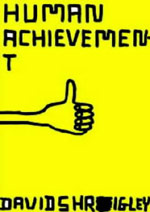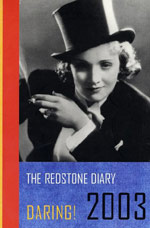Cop that, Col!
| |

| A few years ago Mike brought a little comic book into the staffroom. It was A7 sized and had about four pages. As far as I can recall it told a (very short) tale of someone named Colin, although really I can remember only one frame, which may or may not have been the last of the book. In it, a very crudely drawn head (just a rough circle with a couple of crosses for eyes and a crooked line for a mouth - you know the kind of thing) was shown with a brick bouncing off it. A speech bubble, coming from off-frame, said simply 'Cop that, Col!' It's one of the finest drawings I've ever seen, and I wish I had a copy to hang on my wall. 'Cop that, Col! has become something of a catchphrase since then, used amongst us in school to describe the kind of lovely na¥ve drawings that get awarded the lowest of levels and grades, but that you'd just love to stick on any gallery wall because, hey, they make you smile, make you feel better about the world. When I see David Shrigley's drawings in his Human Achievement book (Redstone Press) I want to say 'Cop that, Col!' Shrigley's drawings are scratchy, innocent, na¥ve, and you could certainly say of them that 'my five year old daughter could draw better than that'. It would be true, too, if what you were talking about was drawings that are 'accurate' and 'lifelike' representations. But that would be to miss the point, because the point of these drawings, and the words that accompany them, is that whilst the appearance is of something simple, the thoughts or the meaning behind them isn't. Which is precisely why, on the whole, a five year old couldn't do them. It's the strange juxtaposition of 'adult' thoughts and 'childlike' execution that makes Shrigley's work so intriguing and appealing. It would also miss the point that in fact it is often very difficult for 'trained' artists (Shrigley is a graduate of the Glasgow School of Art) to 'un-learn' drawing skills, and to draw in such a na¥ve manner, without it appearing stilted and forced. In fact, it's probably misleading to call Shrigley's drawings 'drawings' at all. They are more like field recordings from some kind of vaguely surreal land that mirrors our own 'reality' perfectly; a land where farmers and soldiers discuss the dangers of feeding crack to 'slags', where clever children grow fat and get stuck in concrete pipes on building sites; where men with 'alternative' heads are told by men with 'normal' heads to stay indoors because they frighten the horses. When asked about his work, Shrigley himself reckons that 'what I do is 95 per cent inspiration, 4 per cent tea and 1 per cent actually doing something. It's very rewarding...' It sounds like an ideal job, doesn't it? And certainly, with Human Achievement, David Shrigley had given us something very rewarding indeed. |

| Also published by the Redstone Press is their 2003 diary. It seems that Julian Rothenstien at Redstone had been putting out diaries for 15 years now, and this/next years theme is 'Daring!' So as ever there's a host of images for your delectation, ranging from a photo of a matador's butt after a very close shave, through a marvellous 1930s 'just say no' drugs poster and the cover of Abbie Hoffman's Steal This Book, to Roger Hilton's masterful untitled gouache from 1973. With an image for every week of the year, there's obviously loads to keep you entertained, but a few that have me looking forward already are: The still from the 1916 movie The Dividend, showing 'scandalous sleepers in the opium den' (December 22 - 28); Benjamin Peret insulting a priest (November 3 - 9); 'the snowman; a cocaine user, photographer unknown, Germany 1931 (July 28 - August 3); Douglas Gordon's Letter No.5 (Feb 24 - March 2), and the eerily haunting photograph (May 12 - 18) of the Goddess of Democracy in Tiananmen Square, 1989, before the tanks rolled in... So as a collection of inspiring and illuminating images, it works admirably, whilst as a diary it works as, um, well as a desk diary ought to I suppose. There's space for you to write in all your appointments with other fabulous creative types (or, for the more humdrum amongst you like me, dates of parents evenings and coursework deadlines), nice coloured blank pages at front and back for notes and doodles, and a couple of paper pockets to store postcards and old train tickets. Nifty. © 2002 Alistair Fitchett |